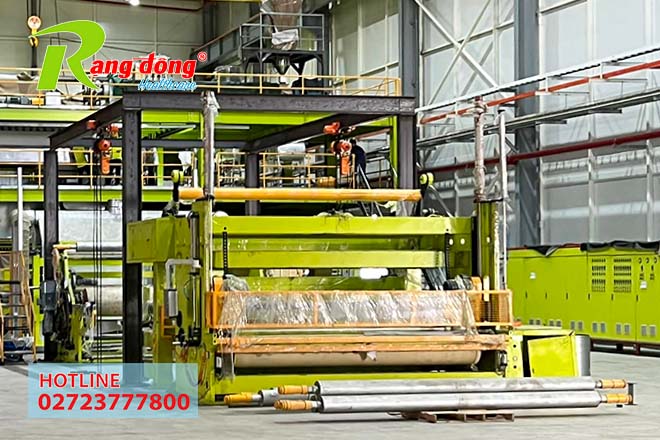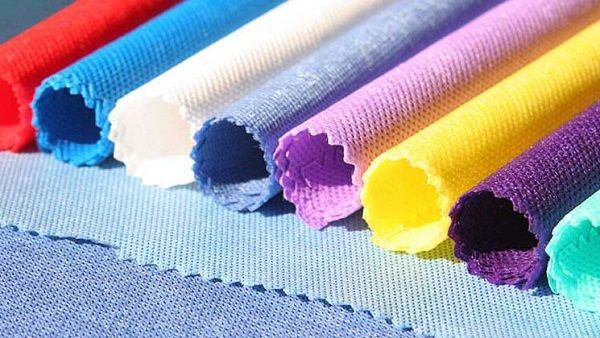Non-Woven Fabric Production Process Product information 27/04/2023
Rang Dong Healthcare Joint Stock Company aims to prioritize “community health” as the guiding principle of its operations and development. The company invests heavily in modern equipment and technology to produce products to U.S. standards. Non-woven fabric is one of the products manufactured by Rang Dong Healthcare.

Non-Woven Fabric Production Process
Non-woven fabric is a type of fabric produced by bonding fibers, cotton, or paper using mechanical, chemical, or high-temperature methods without the traditional weaving process. Non-woven fabric is widely used in various industries, including textiles, woodworking, agriculture and food production, packaging, water filtration, and hygiene.
Applications of Non-Woven Fabric
Non-woven fabric has diverse and widespread applications in various industries, including:
- Environmental Protection: Replacing plastic bags with non-woven shopping bags, garbage bags, and paper and plastic alternative packaging materials.
- Medical: Used in the production of medical bandages, medical masks, personal protective equipment, medical supplies, helmets, shoes, and other medical products.
- Industrial: Used to manufacture protective products, sound insulation materials, insulation, filtration materials, waterproof and slip-resistant materials.
- Food: Used in the production of food packaging products such as tissue paper, food wrappers, food storage box liners.
- Home: Production of household products such as towels, tablecloths, curtains, floor mats, and bedding.
- Technology: Manufacturing electronic components, electronic packaging, electronic protection, and filter membranes.
Steps in the Non-Woven Fabric Production Process
- Material Preparation: Materials such as polyester, polypropylene, rayon, viscose, cotton, and other materials are cut into long fibers and processed to ensure quality.
- Fiber Blending: Fibers are mixed together to create a fiber blend.
- Fiber Bonding: The fiber blend is passed through a bonding process using heat or chemicals to create bonds between the fibers.
- Non-Woven Fabric Structure Formation: Fibers are fed into a press and compressed to create the non-woven fabric structure.
- Surface Treatment: Non-woven fabric undergoes surface treatment to ensure functionality and aesthetics.
- Quality Inspection: Non-woven fabric is inspected to ensure the quality of the final product.
- Rolling and Packaging: Non-woven fabric is rolled and packaged for delivery to customers.

The steps in the non-woven fabric production process can vary depending on the manufacturing technology and the intended use of the final product.
Non-Woven Fabric Production Technologies
- Needle Punching Method: Uses needle-punching machines to bond fabric fibers together. This process doesn’t involve weaving but instead uses fabric fibers and adhesive materials to create non-woven fabric. It’s used in various industries, including medical, household, toy production, and other industrial applications.
- Thermal Bonding Method: This method produces non-woven fabric by using heat to fuse polyester or polypropylene fibers. Non-woven fabrics produced this way are highly durable and resistant to water and chemical agents, making them suitable for applications like bags, lining fabric, protective clothing, and bedding.
- Chemical Bonding Method: Chemical compounds are used to bond non-woven fabric fibers together. After the fibers are bonded, the fabric can be cut into sheets or rolls for various applications, including hygiene products, household items, medical products, and many industrial applications.
- Mechanical Bonding Method: Mechanical bonding is used to connect fabric fibers together. This method creates non-woven fabric products with high strength and rigidity, often used for products like bags, floor mats, and other items.
Applications of Non-Woven Fabric in Production
Non-woven fabric finds applications in various industries:
- Medical Product Manufacturing: Production of medical products such as medical masks, bandages, surgical gowns, shields, and more.
- Hygiene Product Manufacturing: Manufacturing hygiene products like diaper liners, sanitary pads, wipes, tissue paper, and more.
- Consumer Product Manufacturing: Creating consumer products such as bags, toys, mattress protectors, and more.
- Industrial Product Manufacturing: Production of industrial items like air filters, water filters, filter paper, and more.
- Construction Product Manufacturing: Construction-related applications, such as geotextiles, sunshades, rain covers, and more.
- Automotive Product Manufacturing: Making automotive products like soundproofing, seat cushions, and more.
- Packaging Product Manufacturing: Production of packaging materials, product bags, and more.
Benefits of Using Non-Woven Fabric
- High Durability: Non-woven fabric is robust and resistant to tearing, fraying, or breaking.
- Excellent Absorbency: It can absorb liquids effectively, making it ideal for medical supplies, wipes, and more.
- Breathability: Non-woven fabric allows air to circulate, making it suitable for clothing, shoes, and household items.
- Recyclability: It can be recycled multiple times without losing its original properties, reducing environmental impact.
- Cost-Effective: Non-woven fabric production is cost-effective compared to traditional fabrics like woven, metal, or plastic.
- Thickness and Rigidity: Non-woven fabric can be produced with different thicknesses and degrees of rigidity based on manufacturing processes.
Importance of Non-Woven Fabric in Production
The importance of non-woven fabric in production is significant. Firstly, non-woven fabric offers versatility in terms of physical and chemical properties, allowing it to be used across various applications. Secondly, it often has a lower production cost compared to traditional fabrics while outperforming them in minimizing waste and optimizing raw material efficiency. It can be produced on demand, reducing the need for cutting, sewing, and processing excess fabric, thereby minimizing production waste and maximizing efficiency.

Non-woven fabric is a promising industry for the future, given its versatility, cost-effectiveness, and eco-friendly characteristics, especially in the medical industry.






